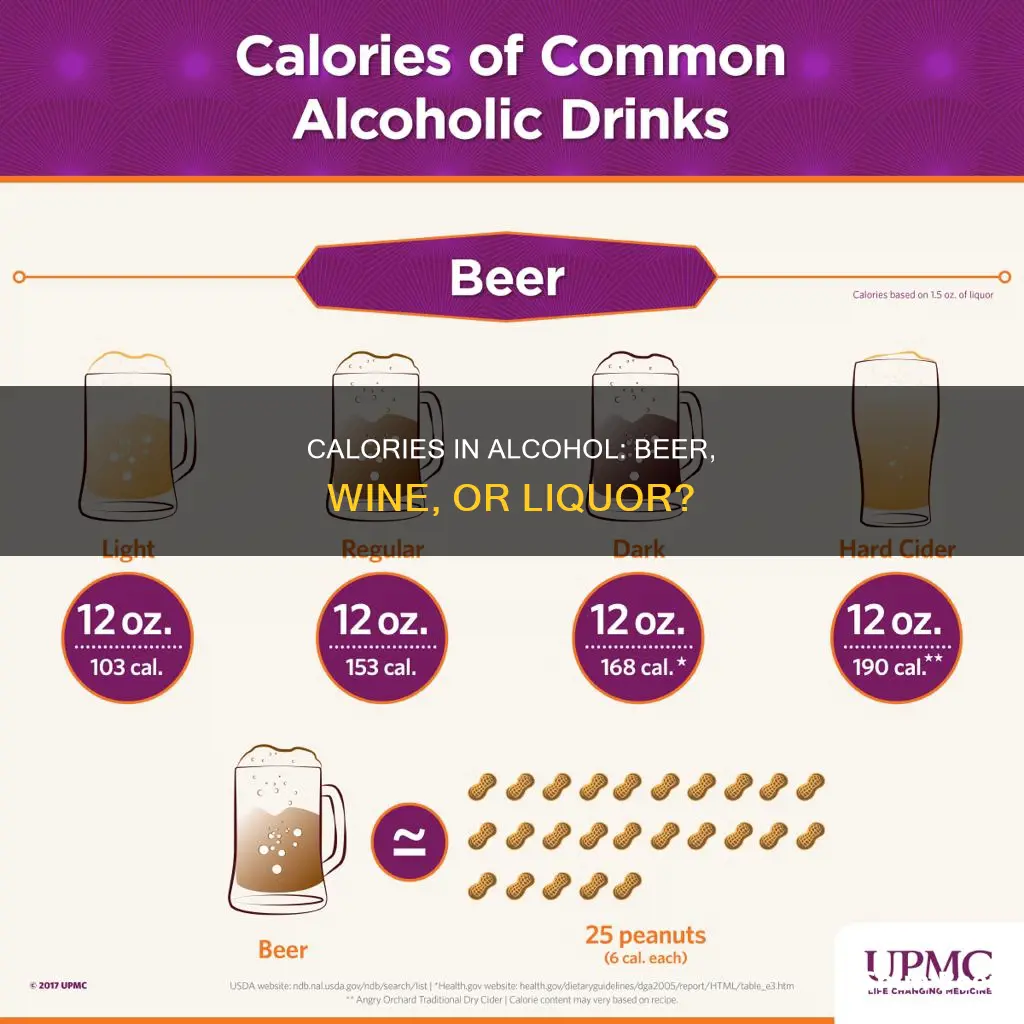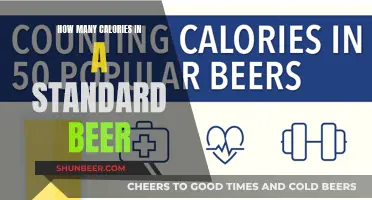
Alcoholic drinks are not considered healthy, but some are more waistline-friendly than others. Beer, wine, and liquor all have different calorie counts, and the calorie difference in beer and wine, in particular, comes from the leftover carbohydrates in beer, as wine usually has a lower sugar content. Pure alcohol contains 7 calories per gram, and spirits such as vodka, gin, rum, and tequila contain around 96-97 calories per 1.5-ounce shot. Beer typically has between 4-7% alcohol by volume, and wines have between 120-210 calories per 6-ounce glass.
What You'll Learn

Beer has more calories than wine, but wine has more sugar
Alcoholic drinks are not exactly nutritious, and consuming them can make it challenging to lose weight. However, some drinks are more waistline-friendly than others.
Generally, beer has more calories than wine. A pint of lager has around 180 calories, which is 50% more than a small glass of wine. A 5% ABV pint of beer has 239kcal, while a 12% ABV 175ml glass of wine has 133kcal. However, the calorie difference between beer and wine is mainly due to the leftover carbohydrates in beer, as most wines have a low sugar content.
Beer is made from grain, which stores carbohydrates in the form of starch. During the brewing process, enzymes in malted barley break down the starch into smaller sugar pieces. While the smallest pieces are converted to alcohol by yeast, some larger pieces remain, contributing to the overall calorie count of most beers.
Wine, on the other hand, has very little sugar left over from the original grape sugar after fermentation. Unless it's a dessert wine, the amount of sugar in wine is generally small and does not significantly contribute to its calorie count.
Red wines have 25 calories per ounce, while white wines have 24. This means that a 750ml bottle of red wine has 632 calories, and a bottle of white wine has 607.
When it comes to weight loss, neither beer nor wine is a smart choice in excess. While wine has a lower carbohydrate count than beer, it sometimes has a higher sugar content. Alcoholic drinks can hinder weight loss goals when consumed in large amounts, as they provide empty calories without essential macronutrients like healthy protein, fat, and fiber.
Beer Calories: Friend or Foe?
You may want to see also

Spirits are a relatively lower-calorie option
When comparing beer and wine, the calorie difference is mainly due to the leftover carbohydrates in beer. Beer is made from grain, which stores carbohydrates in the form of starch, and these leftover carbohydrates contribute to the overall calorie count. A pint of lager, for example, has around 180 calories, which is 50% more energy content than a small glass of wine. However, wine also has a relatively low sugar content, and red wines in particular have been associated with long-term cardiovascular benefits due to the presence of resveratrol, a chemical compound that may also help with cancer prevention.
While the calorie difference between beer and wine may not significantly impact short-term weight gain, the authors of a recent review of studies noted that the longest study only lasted 10 weeks, and minor weight gain over a longer period could eventually add up. Therefore, for those conscious of their calorie intake, opting for spirits could be a wiser choice.
It is worth noting that other ingredients and mixers can significantly impact the calorie count of an alcoholic beverage. For example, margaritas and pina coladas can have close to 500 calories per drink, depending on the size and preparation. Therefore, it is recommended to stick to zero-calorie mixers, such as diet cola, soda water, or seltzer, to keep the overall calorie count low.
In conclusion, while all alcoholic beverages contribute empty calories to your diet, spirits are a relatively lower-calorie option when consumed in moderation and paired with zero-calorie mixers. However, as with any alcoholic drink, moderation is key to maintaining a healthy balance.
Calorie-Counting: Mosaic Promise Founders Beer Edition
You may want to see also

Dark beers are heavier and tend to have more calories
When it comes to alcoholic drinks, it's a common misconception that darker drinks are heavier and have more calories. While this is true for drinks like cola, where the colour indicates the sugar content, it's not always the case for beer. However, dark beers are often associated with being heavier and having more calories.
The colour of beer is directly related to its malt content. The fermentable sugar in most craft beer comes from malted barley that has been kilned and roasted. Light roasted malts produce straw and golden colours, medium roasts produce amber and copper colours, and darker roasts produce brown and light black colours. The darkest beers are made from the heaviest roasts, which yield black colours and burnt flavours.
However, it's important to note that dark malts typically only make up 1-5% of the overall recipe, so a beer can be dark in colour without having a high sugar content. In fact, the sugar content and calories in beer are directly correlated with its alcohol content. Higher-alcohol beers tend to have more calories, regardless of their colour. For example, Victory Brewing Co.'s Golden Monkey, a very pale Belgian-style tripel with 9.5% ABV, has over 300 calories per 12 ounces, while Samuel Adams' Black Lager, a light-bodied beer with only 4.9% ABV, has under 200 calories per 12 ounces.
So, while it's true that some dark beers are heavy and high in calories, it's not always the case. The colour of a beer is not a reliable indicator of its calorie content, as the alcohol content and other factors play a much more significant role.
Golden Light Beer: Calories and Nutrition Facts
You may want to see also

Red wine has more calories than white wine
When it comes to alcoholic drinks, some are more diet-friendly than others. Generally, spirits such as vodka, gin, tequila, rum, and whiskey are among the lowest-calorie options, with an average of 97 calories per 1.5-ounce shot. A glass of champagne (4 ounces) and a traditional martini (2.5 ounces) are also relatively low-calorie, containing approximately 84 and 124 calories, respectively.
Now, let's focus on the comparison between red and white wine. Red wines typically have 25 calories per ounce, while white wines contain 24 calories per ounce. This means that a standard 750ml bottle of red wine has 632 calories, compared to 607 calories in a bottle of white wine. Therefore, red wine has slightly more calories than white wine.
The difference in calorie content between red and white wine can be attributed to the winemaking process and the presence of grape skins during fermentation. Red wine is usually made by fermenting crushed red grapes with the skin, seeds, and stems, which contributes to its higher calorie content. On the other hand, white wine is typically made by pressing the grapes to remove the skins, seeds, and stems before fermentation, resulting in slightly lower calorie levels.
It's important to note that the calorie content of wine can vary depending on factors such as alcohol by volume (ABV) percentage and the specific type of grape used. However, as a general rule of thumb, white wines tend to be lower in calories than reds.
Calories in Castle Light Beer: What's the Count?
You may want to see also

Alcohol affects weight loss goals when consumed in large amounts
Alcoholic drinks can negatively impact your weight loss goals when consumed in large amounts. While beer, wine, and liquor have distinct differences in flavour, ingredients, and nutritional value, they all contain calories that can hinder weight loss.
Beer is made from grain and yeast, and its calorie content varies depending on the type. Most light beers have between 60 and 120 calories, while dark beers, which tend to have more carbohydrates, range from 100 to 300 calories. The leftover carbohydrates in beer contribute to its higher calorie count compared to wine.
Wine, on the other hand, is made with fermented grapes and typically has a lower sugar content. It contains between 120 and 210 calories per six-ounce glass, with red wines having slightly more calories than white wines. Wine also has a lower carbohydrate count than beer, but it may have a higher sugar content.
Liquors like vodka have a lower calorie count than most beer and wine, with 96 calories per 1.5 fluid ounces. However, it's important to consider the added calories from mixers, juices, and drink mixes.
When consumed in large amounts, alcoholic drinks can add 200 to 300-plus empty calories to your daily diet. These calories do not provide essential macronutrients like healthy protein, fat, or fibre. Additionally, alcohol can make it more challenging to lose weight and may lead to weight gain over time.
To minimise the impact of alcohol on your weight loss goals, moderation is key. Opt for lower-calorie and low-carbohydrate options, such as light beers or dry wines. Be mindful of the extra ingredients and mixers added to your drinks, as these can significantly increase the calorie count. Checking the alcohol by volume (ABV) and nutritional information on labels can help you make more informed choices. Remember, while alcohol can be part of a nourishing diet and lifestyle when consumed in moderation, it does not contribute to weight loss goals and should be consumed in conjunction with a balanced diet and regular exercise.
Calories in Shots vs. Beer: Which Drink is Worse?
You may want to see also
Frequently asked questions
It depends on the type and volume of the drink. Generally, beer has more calories than wine, but wine tends to have a higher calorie count than liquor. For example, a pint of lager has around 180 calories, while a small glass of wine is around 130 calories. A shot of liquor (1.5 ounces) has an average of 97 calories.
The calorie count in alcoholic drinks is influenced by the amount of alcohol, the total volume of the drink, and the amount of carbohydrates, sugars, and mixers.
Liquor tends to be the most diet-friendly option, as it has a lower calorie count than beer or wine. For example, a shot of vodka, gin, rum, whiskey, or tequila has an average of 97 calories. Other low-calorie options include a glass of champagne (about 84 calories per 4 ounces) and a traditional martini (around 124 calories for a 2.5-ounce serving).
Alcohol contains empty calories, meaning they provide no nutritional value. Consuming large amounts of alcohol can lead to weight gain, especially if mixed with high-calorie ingredients. Additionally, alcohol can contribute to weight gain by increasing appetite and decreasing inhibitions, leading to overeating.







